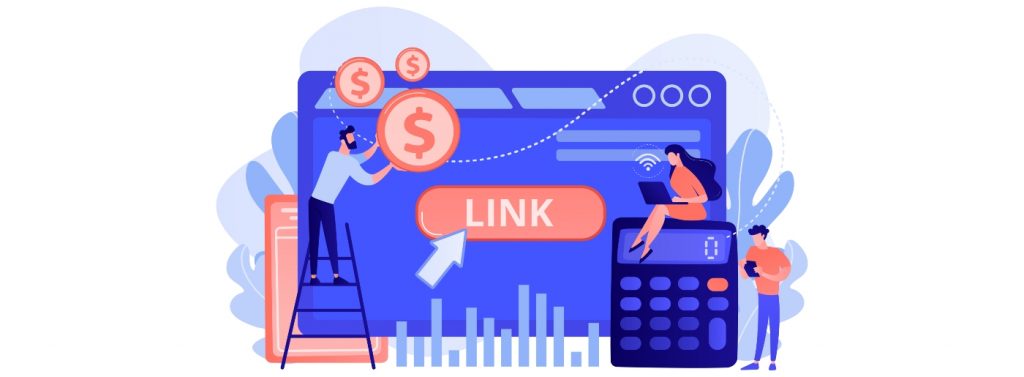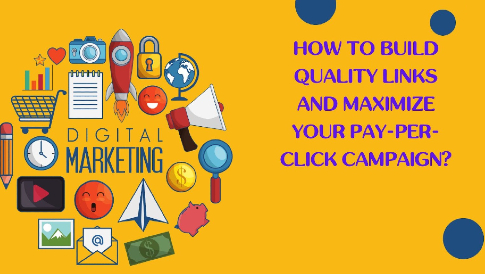If you want people to find your website easily and help lower your advertising costs, you need good search engine rankings for your important keywords. This means working on SEO or Search Engine Optimization. One way you can do this is by getting backlinks from other websites.
That’s like a vote of confidence showing that your website is important. You also want to keep track of how your targeted keywords are doing. With a pay-per-click campaign or pay-per-click advertising, you can do that. Finally, creating high-quality inbound links is a quick and easy way to get higher search engine rankings.
What Is Link Building and PPC?
HTML backlinks or external links are inbound links used to connect one website to another. Like one’s actual reputation, online reputations serve as money on the Internet.
Your website’s internal links to other sites under the same domain will function similarly. Businesses will pay millions to get to the top of search engine rankings. Therefore, looking into trustworthy link-building service providers to buy backlinks is a good idea. They are equipped with the expertise and experience to provide whitehat link-building services. Google likes many internal links to a single page on your site.

With pay-per-click (PPC) advertising, you only pay when a user clicks on your ad after searching for one of your targeted keywords or phrases. Pay-per-click advertising, if executed properly, can generate high-quality leads. A faultless user experience may boost your PPC ROI.
Your advertising will appear on the SERP and send traffic to your site; the amount you pay depends on how many people click on your ad.
Google and Bing utilize PPC advertising in their SERPs, but social media sites also use it more.
How To Build Quality Links?
Even though there are many link-building methods, your campaigns should be tailored to your goals. However, several tried-and-true link-building services consistently provide positive results for pay-per-click campaign.
1. Excellence in Content Production
Content is why people go online. If you make great content, more people will come to your website. Try different kinds of content to find the best fit for your goals. SEO has been an important way to get people to see what you write, and it can help make sure people find your webpages. Write in a way that readers will want to keep reading.

2. Articles for Field Publications, Journals, and Blogs
It’s important for businesses to share helpful articles in places like journals, magazines, and blogs. This is called “guest blogging” and it can help you build your company’s reputation.
You should use high-quality content to draw attention to yourself, get valuable links, and show people how knowledgeable you are in your field. You have to put some time and effort into this, either by being an expert or having access to one.
Plus, you need to link back to other websites with useful information about what you’re talking about. That way, people will be more likely to link back to your own website.
There is nothing complicated about the pillar link tactic:
- Ensure your site has useful material describing a topic, idea, or common viewpoint. Collecting and analyzing data is crucial.
- Submit an article to a trade journal.
- Use the notion, idea, or viewpoint described in 1.
- Link to your site’s content on that topic, viewpoint, or perspective to save time. In addition, you should provide the reader with some more background.
3. Establish Connections With Clients and Collaborators
Getting links from companies you already deal with often or clients dedicated to your brand is easy. You may offer partnership badges or write product reviews (graphic symbols denoting mutual esteem). These two alternatives provide the material and links to you.
4. Check for Mentions of Competitors
Examining the competition is a crucial part of any SEO strategy. Monitoring what others say about you online may reveal how they build their inbound links.
Backlinks grow after social media mentions. Brand value and recognition may be increased by receiving mentions.
5. Consult Infographics
Infographics are a great tool to help you get more viewers. They are full of interesting visuals that will attract customers to your site. Not only that, they’re easy to share with others. Plus, SEO professionals can create helpful infographics for you to use. Use graphs or charts to get your point across if regular pictures don’t work!
6. Broken Link Building
Surfing the web can be a wild and unpredictable ride! You could end up somewhere different than you expected whenever you search for something. Broken links are like hidden detours that can lead you down unexpected paths. Like any other method, they must be used carefully so you don’t go too far off-track. That way, your surfing journey can be a fun, exciting, and inspiring experience!
Consider the following characteristics of high-quality links:
- Relevance
- Usefulness
- Natural
- Editorial
7. Brand Mentions Without Links
We may still need to mention ourselves in this day of much information. When it comes to link building, this is a goldmine. Many services monitor online brand mentions and warn you. However, you should also consider whether they improve your website.
8. Guest Posting
Guest blogging is a great way to get more people to see your business. When you write an interesting and helpful article on someone else’s website, it will be seen by more people. You’ll also build your brand’s reputation and connect with new customers. Working with a professional link-building Agency like Desire Marketing for extra help might be worthwhile to make sure you get the most out of guest blogging.
Google’s analytics webpage welcomes guest posts from outside contributors. The advantages of guest posting include:
- Communicate with your customers to build loyalty
- Establish contact with other bloggers
- Recruit more people to join your email list
- Promote your website by connecting to the main page.
Using this method, you may quickly and easily get high-quality backlinks with high DA and PA.
9. Interview-based Link Building
Going to an interview is a great way to get the spotlight. When you have an interesting talk with some thoughtful questions, the article turns out to be fascinating. Including a link to your website in that published interview can help your search engine rankings and bring a lot of attention to your name and brand. Plus, people who read the article will be directed to the publisher’s site. You can also use referrals as another method for landing an interview.
10. Analysis of Link Gaps
If you want to know which websites are connected to your competitors but not to you, doing a link gap study is the way to go! This helpful service compares up to five competing websites and finds sites with links that could be beneficial to you.
By looking at the authority score, matching, and referring domains, it can give you a better understanding where you’re falling short. Doing a domain-level study will help you get connected in the right places, so don’t wait any longer – take control of your website’s links and start your link gap study today!
Nonetheless, the research it provides is much more precise. It’s not only whole websites that may benefit from Link Gap Analysis but individual pages.
11. Locate Credible Resources to Connect To
We may link to other websites from ours as long as they have good-quality links. Getting good links that point back to our website is also important so more people can find it.
We need to use a backlink service that provides reliable and relevant information to ensure we get great links. We also want our links to be placed in interesting parts of the text so they sound like they belong there. That way, no one else will link to the same page.
How to Maximize Your Pay-Per-Click Campaign?
You may be familiar with the fundamentals of PPC campaign setup. But remember that there are always more steps you may take to improve it.
1. Be Wise About Your Keyword Selection
Choosing the right keywords for your pay-per-click campaign is key to success. The more relevant and targeted your keywords, the better your results. Research and refine your keyword lists to ensure you’re targeting relevant traffic and reaching your desired audience.
Consider the value of long-tail keywords to increase visibility at lower costs. Being wise about your keyword selection can help you maximize your PPC efforts and drive better ROI.
2. Think About Including a Few “Negative Keywords”
Including negative keywords in your keyword lists can help filter out unwanted impressions and improve click-through rates. With an effective negative keyword strategy, you can stop your ads from appearing alongside irrelevant search terms, maximize your ROI, and reach the right people for your business.
3. Create Keyword Ad Groupings (Skags)
Successful PPC campaigns start with well-structured keyword ad groups designed to target specific audiences. These groups should focus on a single theme and set of related keywords, so you can maximize your click-through rate while staying focused on your budget.
Relevant and targeted ad content is key to making the most out of your PPC campaigns. Ensuring your keyword ad groups are well-designed can help you maximize your pay-per-click campaign to reach the right people and drive conversions.
4. It’s Best to Keep Search Ads and Content Ads Apart
Search ads can help you target potential purchasers looking for a specific product or service, while content ads focus more broadly on delivering a message or engaging with potential customers. Keeping the two ad types separate will help you focus your marketing efforts and be more effective in reaching your desired audience.
In addition, it’s key to use targeted keywords, text, and relevant visuals to ensure that your ad stands out from the competition. By creating distinct and tailored ad sets, you can maximize the impact of your pay-per-click campaign.
5. Optimize the Reach of Your Ad Campaigns
Not all marketers target their audiences as precisely as they might. To optimize your PPC account‘s efficacy, use its targeting options.
We recommend you focus on the following while developing your pay-per-click campaign strategies:
- Numerous Nations
Set up a separate ad group for each country you want to promote. Otherwise, just run your ad in the United States.
- Micro-geographic emphasis
Your advertising account’s micro-geographic targeting lets you target your company’s zip codes.
- Day and time
Put your ads on a schedule so they only run at the best times.
- Don’t Forget the “Call to Action”
A call to action is a great approach to wrap out an advertisement. The copy’s main body should provide value and center on the reader. Put simply, demonstrate the value added by using your service. What are they going to receive?
A prospect should know what to do next when they reach your call to action. A solid call to action will also convince the reader to act swiftly to reap the benefits of the advertisement’s offer.
To be successful, a CTA must:
- Be intriguing
- Provide a blatant advantage to whoever is using it
- The current rate of conversion must be maintained.
- Promptly induce action
Simple calls to action like “sign up,” “download now,” and “start my free trial” have been demonstrated to boost conversion rates.
6. Always Keep Tabs on Every Parameter
PPC campaigns are a powerful way to generate leads, grow visibility, and increase conversions. However, to maximize the effectiveness of your pay-per-click campaign, you need to continually monitor and adjust certain key parameters.
Keep close tabs on your CTR, CPC, target keywords, ad groups, and landing pages to ensure your pay-per-click campaign reaches its desired goals. By monitoring and adjusting these variables regularly, you can ensure that your PPC campaign runs smoothly and that you get the most out of it.
7. Research and Identify Long-tail Keywords
Many organizations and individuals use short-tail keywords. It is the easiest way to reach most people with your bids, boosting the possibility of clicks. It is essential to identify your company’s most relevant long-tail keywords.
The organic search results that have brought visitors to your site in the past are a fantastic place to start.
8. Ad Copy Test
It might take a lot of work to write compelling advertisement copy. Your pay-per-click campaign’s return on investment (ROI) will only be maximized if you try several forms of advertising to see which ones perform best.
Most pay-per-click ad networks allow you to rotate adverts for the exact keywords. Change your settings to show adverts randomly instead of the platform’s algorithm to provide a fair test.
9. Establish Separate Mobile Ad Groups
Dividing your ads into different ad groups helps you strategize more effectively and target more effectively. By breaking your ads into separate mobile ad groups, you can tailor bids and adjust targeting to maximize performance and conversions on mobile campaigns.
Separate mobile ad groups are also helpful in tracking each campaign’s performance to better understand where you should focus your efforts and give you the ability to optimize faster.
10. Keep Tabs on Your ROI
Tracking success metrics such as clicks and impressions can help you identify successful ad campaigns to increase conversions and minimize costs. Regularly check and adjust your bid strategies and target audiences to maximize the competitiveness of your ads.
Finally, use reporting analysis to continuously track and analyze PPC returns to ensure you are getting the most out of your pay-per-click campaign.
Frequently Asked Questions
Why Should I Invest in Building Backlinks to My Site?
Backlinks are one of many elements in the search ranking algorithm, making them essential to any successful SEO effort. Your content’s reliability is determined by the quantity and quality of websites that link to it. These backlinks boost your site’s legitimacy.
Just How Long Does It Take To Launch a Link-Building Campaign?
If you want your link-building campaign to get going, it usually takes around three months. You’ll need about six weeks to brainstorm ideas and create content, then another four to six weeks to promote it. Once the promotion is done, people might still keep talking about it and linking to it!
Can a Particular Number of Links Be Guaranteed for a Campaign?
It’s impossible to predict how many links a piece of content will produce as it’s a white hat method. The success of a work is determined by whether authors and newspapers cover and link to it.
The relatedpay-per-click campaign creates seven to one hundred backlinks to the brand’s website.
How Does Pay-Per-Click Advertising Work?
Pay-Per-Click Advertising is a way to get your message seen by people searching for something related to what you offer. When someone types in a keyword related to your product or service, your ad shows up in the search results list so they can find you more easily. The ads are chosen based on an auction system where the most relevant ads are shown more often. So, if you have good keywords and an engaging ad, there’s a better chance that yours will be seen first.
How Much Does PPC Advertising Cost?
The amount you pay each time someone clicks on one of your ads is called the Cost Per Click (CPC). You can choose a budget that fits your plans and don’t have to commit to anything. For starters, many companies spend no more than $10 per day with their pay-per-click campaign. Plus, you’re free to make changes any time you like!
What Exactly Are Pay-Per-Click Advertisements?
Pay-per-click (PPC) advertisements are a type of online marketing where businesses pay an agreed-upon fee each time a customer clicks on their advertisement. It is a useful tool for businesses to direct potential customers to their websites, products, or services.
PPC is especially helpful for small businesses that can’t afford more expensive brand promotion methods. By carefully targeting their pay-per-click campaign, businesses can capture a greater ROI on their budget.
Conclusion
Quality link-building and pay-per-click campaign are essential for achieving successful marketing goals. You can maximize your reach and drive more conversions with the right approach.
Link building is a time-consuming process, but with careful planning and data analysis, you can make sure your efforts don’t go to waste. Pay-per-click advertising can be an excellent way to capture additional leads and customers without spending a lot of money.
By building quality links, creating compelling ad copy, and engaging regularly with your audience, you can optimize your pay-per-click campaign and get the most bang for your marketing buck.
